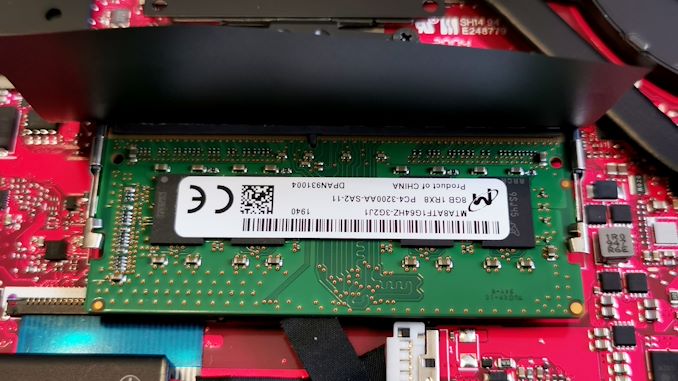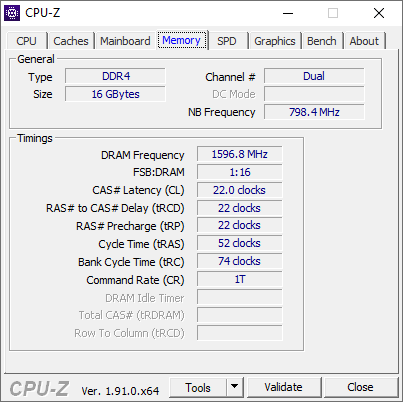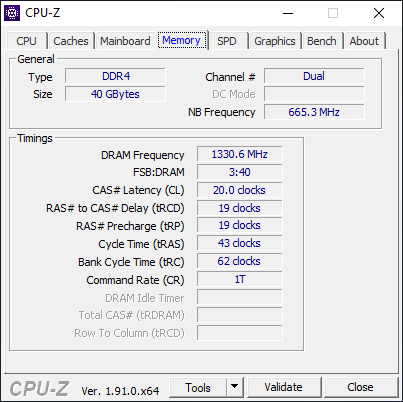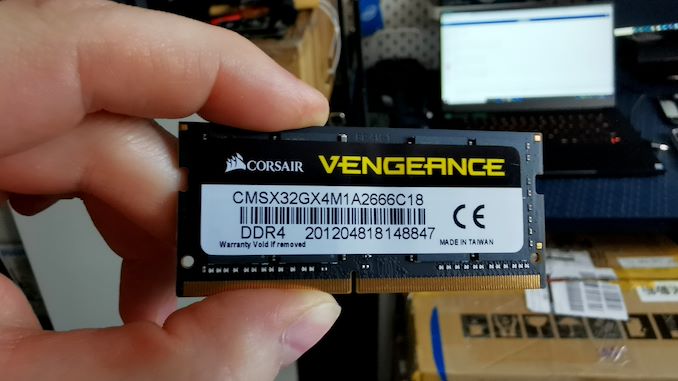AMD’s Mobile Revival: Redefining the Notebook Business with the Ryzen 9 4900HS (A Review)
by Dr. Ian Cutress on April 9, 2020 9:00 AM ESTRyzen 9 4900HS with DDR4-2666 and DDR4-3000
In our ASUS Zephyrus G14, we have a total of 16 GB of DDR4. This is split between a single SO-DIMM module of 8 GB, and a set of 8 GB memory soldered onto the board. AMD will offer a version with 16 / 16, however this might come at a later date.
This memory is running at the AMD recommended for these processors, DDR4-3200. Through our inspection tools, we can tell that this memory is running with subtimings of 22-22-22 with a command rate of 1T. The command rate is certainly good, however the 22-22-22 is a little slower than what we see on a desktop system running at this speed, because here we have a system that conforms to JEDEC’s subtiming requirements.
For our memory testing we wanted to see what speeds and capacities we could achieve. Corsair very kindly sent us some modules of 16 GB DDR4-3000 and a module of 32 GB DDR4-2666. This would give our system either 24 GB or 40 GB total respectively, which for a machine designed to do heavier duty workloads, having >16 GB is certainly welcome, as long as the performance hit isn’t too much.
I installed the 32 GB module, and the system booted first time with no fuss. A quick look to see if all the capacity was seen, and we had a total of 40 GB. The speed was also as expected, at DDR4-2666 but with subtimings of 20-19-19 1T.
However, when we put in the module of 16 GB DDR4-3000, to get a total of 24 GB, the detected speed inside the system was only DDR4-2666. Looking at the module settings, this was because the DDR4-3000 speed was actually an XMP profile, and ASUS has not enabled the ability to set XMP profiles here.
We were able to get DDR4-2666 on the 32 GB module because this is the base frequency and settings for the module. The same with the 8 GB module that came with the system – it was flashed so that the basic SPD setting was DDR4-3200. If users want to get high capacity modules with the faster DRAM speeds on this system, they will have to configure the primary SPD profile of their modules, which isn’t an easy thing to do.
As a result, our tests are going to come down to the 8 GB DDR4-3200 module that came with the system, and compare it to the 32 GB DDR4-2666 module. Note that the latter is an 8+32 configuration, which is expected to run in dual channel for the first 16 GB, and then single channel for the next 24 GB.



With our AI test, there’s a ~20% benefit from having the faster memory, which decreases slightly when moved to a limited power budget.

We didn’t see any difference in something like Cinebench.

There was more of a difference in PCMark 10, however PCM10 isn't that great in showing where the bottlenecks are.
Integrated Graphics Tests


For the Civ 6 graphics test, the difference in performance between the two memory settings is really significant. This sort of game cares less about FPS, however going down to 22 FPS for 1080p Max and No MSAA means that the user probably has to dial that back a bit to get something more reasonable.


Going from plugged in to not plugged in, we didn’t see much of a change with the slower memory, however the DDR4-3200 setting still gets a serious benefit over the DDR4-2666 arrangement.

For Final Fantasy, there a significant change - moving up from DDR4-2666 to DDR4-3200 affords a +30% improvement.
Discrete Graphics Tests




In each case, the faster DRAM actually improves discrete graphics performance.
Quick Thoughts
Overall, 16 GB of memory in a system like this isn't the best configuration - people who need the power are going to likely want 32 GB. However, users putting in their own fast module when buying the 16 GB version are going to have to be careful about the performance. Both the integrated graphics and the discrete graphics take a knock on performance going down from DDR4-3200 to DDR4-2666.















267 Comments
View All Comments
Kishoreshack - Monday, April 13, 2020 - link
@ian cuttresWhy soo harsh on AMD?
Its outdoing intel processor which draw 2 or 3 times more power
It literally smokes any Intel processor in the same power envelope
You should be giving praises & awards to AMD
instead the tone of article doesn't do justice to AMD
Deicidium369 - Monday, April 13, 2020 - link
Facts hurt, huh? It's impressive but not life altering. What sort of awards? "Award for not going bankrupt" or "Award for FINALLY putting something worth purchasing" or "Award because you hut AMD's fee fees"The tone is fair, Ian is a skilled writer and reviewer - I never felt he has leaned more to one side or the other.
destorofall - Tuesday, April 14, 2020 - link
can I give intel an award for "masterfully delaying a node ramp-up for almost half a decade."Korguz - Tuesday, April 14, 2020 - link
they didnt delaying, they screwed up some how, some say intel was too aggressive on what it was trying to do with it, and it didnt workWineohe - Monday, April 13, 2020 - link
This does potentially offer OEMs some breathing room with features, if the CPU and Chipset can lower their costs by a few hundred dollars. They can offer a Notebook with similar or better performance and battery life, with more features. Say a 1TB SSD versus a 512GB, 32GB vs 16GB, better display, or better dedicated GPU. This would easily sway me as a consumer toward the AMD option.Deicidium369 - Monday, April 13, 2020 - link
Nope. Most people would still buy Intel - price isn't most people's primary metric - some buy Intel because why buy something that is "like Intel" when you can, you know, "Buy Intel". OEMs build what people want - and this new CPU will be a major rarity - and will not sell in even large numbers by AMDs standards.Qasar - Monday, April 13, 2020 - link
" OEMs build what people want " or buy intel because intel bribes or threatens them, remember the athlon 64 days ? guess what, intel got taken to court over their shady dealings, and they lost, but i know you won't remember that, because your an intel fanboy, and intel cant do anything wrong.watzupken - Monday, April 13, 2020 - link
Its true that most consumers will still prefer Intel chips due to the reputation they have build for themselves over the years. However in this age where people can find information readily, that advantage may not be firm. With more enthusiasts leaning towards AMD, this may also filter down to those who are not tech savvy through positive word of mouth. For example, it is not uncommon for someone who is not tech savvy to get recommendation from a technology savvy person when buying a computer/ laptop. Moreover, AMD is very aggressive when it comes to the cost of the chips, further adding another carrot to consumers to switch camp. One other key problem was poorer battery life on AMD mobile chips, i.e. Ryzen 2xxx and 3xxx for mobile devices, which is no longer the case here unless the manufacturers deliberately gimp the battery capacity.sleeperclass - Monday, April 13, 2020 - link
No webcam is a big blow. In these times, where everyone is using online chat platforms for communicating such as Teams, Zoom ,etc, this is something that should have just been there.All said and done, good progress by AMD in the mobile cpu space.
Qasar - Monday, April 13, 2020 - link
both of the notebooks i have, have webcams, both are unplugged and i picked up a logitech C920 i think it is, just didnt like the idea of having to tilt the screen so the person i was talking to could see me better, the separate webcam, allows that no matter how the screen is tilted. but to each his own :-)